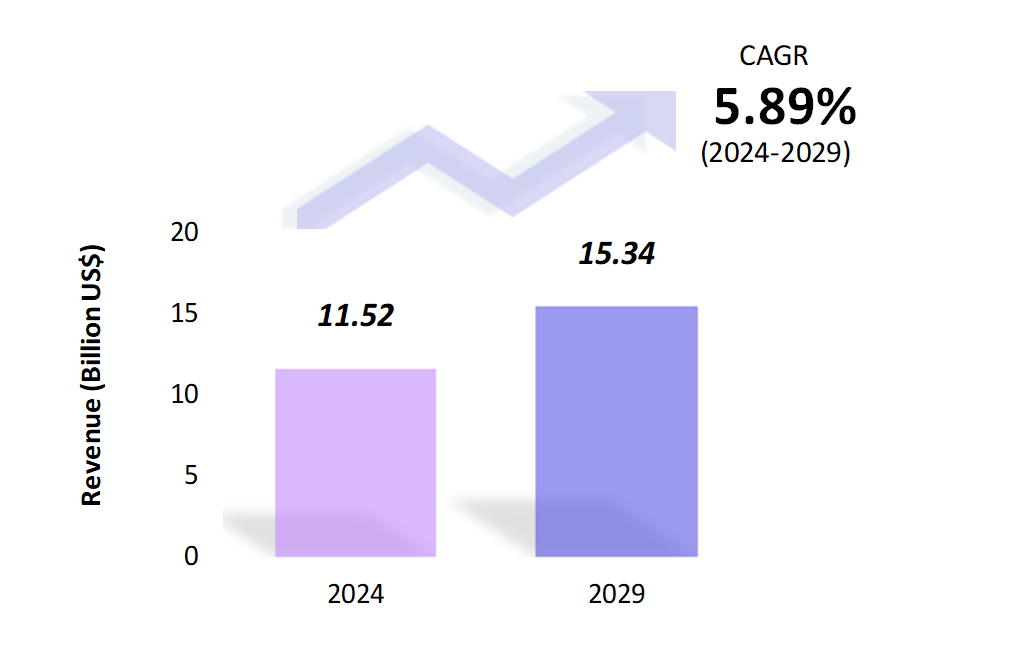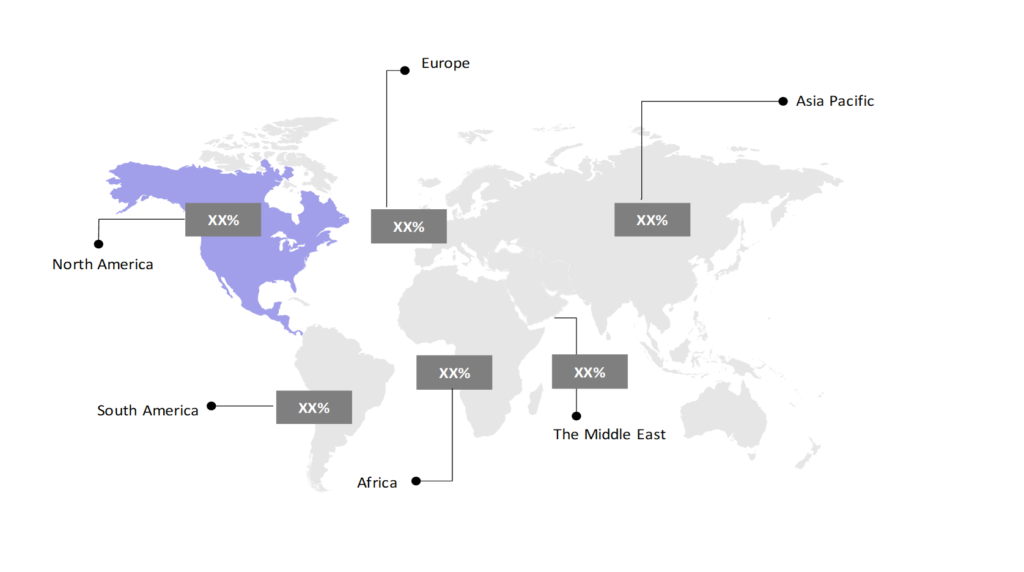Animal Parasiticide Market Outlook: Size, Share, Trends & Growth Analysis (2024-2029)
The report covers a comprehensive analysis segmented by Type (Ectoparasiticides, Endoparasiticides, Endectocides), By Animal Type (Companion Animals, Livestock Animals), By End User (Veterinary Clinics & Hospitals, Animal Farms, Home Care Settings), By Geography (North America, South America, Asia Pacific, Europe, the Middle East, Africa).
Animal Parasiticide Market Snapshot

Animal Parasiticide Market Overview
The global animal parasiticide market is estimated to be at $11.52 Bn in 2024 and is anticipated to reach $15.34 Bn in 2029. The global animal parasiticide market is registering a CAGR of 5.89% during the forecast period 2024-2029.
The animal health industry has witnessed technological advancements that have led to the development of better and safer antibiotics. These advancements include contemporary designs, durable devices, and alternative delivery methods such as drips, oral tablets, and collars. Pet owners are becoming increasingly aware of the importance of disease prevention and control. Veterinarians play a key role in educating pet owners about parasite risks and preventive measures, including the use of antibiotics. Regulatory agencies continue to play a vital role in the creation of commercial animal parasiticides. Strict regulations regarding product safety, performance and environmental impact require industry personnel to conduct continuous research and development to comply with evolving standards.
Emerging markets, particularly in regions with a growing middle class and increasing disposable income, present significant opportunities in the animal parasiticide industry. These markets often have a large population of pets with limited access to parasite prevention products, creating a demand for affordable and accessible solutions. The concept of One Health, which recognizes the interconnectedness of humans, animals, and environmental health, is gaining traction. This holistic approach underscores the importance of controlling parasite in animals not only for their welfare but also for public health and environmental conservation.
Animal Parasiticide Market Coverage
| Historical & Forecast Period | 2018-2029 |
| Base Year | 2023 |
| Forecast Period | 2024-2029 |
| Units | Billion US$ |
| Segments | Type, Animal Type, End User |
| Geographies | North America, South America, Asia Pacific, Europe, the Middle East, Africa |
| Key Vendors |
Zoetis Inc., Merck & Co. Inc., Bimeda Inc., Virbac Group, Norbrook Group. |
Key Geographies of Animal Parasiticide Market, 2023

Porter’s 5 Forces Analysis of Animal Parasiticide Market

Animal Parasiticide Market Trends
Manufacturers of animal parasiticides are diversifying their product portfolios to address a broad range of parasites and animal species. This involves tailoring formulations to target specific types of parasites (e.g., fleas, ticks, worms) and routes of administration (e.g., oral, topical, injectable). Combination products addressing multiple parasites simultaneously are also gaining popularity. Furthermore, advancements in drug delivery systems are facilitating the creation of more convenient and effective parasiticide formulations. These advancements encompass innovative delivery mechanisms such as controlled release implants, transdermal patches, and oral formulations with improved bioavailability. Such innovations enhance treatment adherence and efficacy while minimizing adverse effects.
There is an increasing emphasis on preventative healthcare in veterinary medicine, concerning parasite prevention. Pet owners and livestock breeders are adopting year-round parasite management protocols to mitigate the risks of infestation and reduce reliance on curative measures. Additionally, digital technologies like mobile applications, electronic health records, and telemedicine platforms are being integrated into parasite management strategies. These tools empower veterinarians and pet owners to monitor parasite prevalence, track treatment adherence, and receive personalized treatment recommendations, enhancing overall healthcare outcomes for animals.
Animal Parasiticide Market Driving Factors
Parasitic diseases in farm animals can affect production, growth and reproductive function. Livestock producers are driven to enforce effective disease management techniques to improve production, improve animal health, and reduce the economic costs associated with parasites. The emergence of antibiotic resistance poses a fundamental problem for animal health and agriculture. Resistance reduces the effectiveness of existing pesticides and requires the development of new treatment strategies, including new compounds, combinations and alternative treatments. Advances in veterinary medicine, pharmaceuticals, and drug delivery technology have spurred innovation in animal pesticide production.
New formulations, delivery systems, and treatments make antibiotic products easier to administer, increase their effectiveness, and reduce side effects. Globalization and international trade contribute to the cross-border transmission of parasitic diseases. The movement of animals, animal products and invasive species increases the risk of infection and transmission of parasites and requires international cooperation and coordination in the management of parasitic diseases. Educational initiatives and awareness campaigns targeting veterinarians, livestock producers, pet owners and other stakeholders play an important role in promoting the importance of parasitic control and preventive healthcare practices. Increasing awareness of the risks associated with parasitic diseases and the benefits of using antibiotics is increasing the demand for parasiticide products and veterinary services.
Animal Parasiticide Market Challenges
One of the most important problems in animal parasiticide management is the emergence and spread of drug-resistant parasites. Long-term and intensive use of antibiotics can cause parasites to develop, making some treatments ineffective. Antibiotic resistance requires constant monitoring, control and the development of alternative treatments. Parasites exhibit a complex life cycle consisting of many stages and are sensitive to a variety of treatments. It is important to understand the biology, ecology and behavior of parasites to develop effective antibiotic strategies. However, the complexity of the parasite’s life and its interactions with livestock and the environment make the development of disease prevention and safety plans difficult.
Environmental pollution and ecological impacts associated with the use of parasiticides are growing concerns. Some active components in parasiticides have the potential to endure in the environment, leading to water source contamination and endangering non-target organisms such as beneficial insects, fish, and wildlife. Striking a balance between the necessity for effective parasite control and environmental preservation calls for the development of environmentally friendly and sustainable parasiticide formulations and management practices.
Animal Parasiticide Market – Key Industry News
- In January 2024, Bimeda Inc. launched BOVitalize in the US market BOVitalize is an oral supplement containing essential vitamins and minerals designed for dairy cows, bulls, and ruminating calves.
- In February 2024, Zoetis Inc. announced the expansion of its multi-application diagnostics platform, Vetscan Imagyst, to include AI Urine Sediment analysis. A new feature enables veterinarians to make timely and accurate treatment decision for pets.
- In February 2024, Merck Animal Health acquired Elanco Animal Health Inc., Aqua division. The acquisition includes assortment of medicines and vaccines, nutritional items, and supplements for aquatic species. It also comprises two linked aqua manufacturing plants located in Canada and Vietnam, as well as a research facility situated in Chile.
Animal Parasiticide Market Competitive Landscape
The participants in the global animal parasiticide industry are always developing their strategies to preserve a competitive advantage. Companies primarily use acquisitions, R&D, partnerships, and technological launches. Several important entities in the animal parasiticide market include Zoetis Inc., Merck & Co. Inc., Bimeda, Inc., Virbac Group., Norbrook Laboratories Ltd., and others.
In the animal parasiticide industry, the global competitive scenario remains fluid, as companies persistently innovate and adjust to market shifts, regulatory updates, and evolving consumer needs. Sustaining competitiveness demands a blend of product innovation, strategic alliances, adept marketing strategies, and a steadfast dedication to quality, safety, and environmental sustainability. Strategic marketing and branding tactics play a vital role in establishing brand recognition, fostering customer loyalty, and distinguishing products from competitors within the market. Businesses allocate resources towards targeted marketing initiatives aimed at veterinarians, pet owners, livestock producers, and relevant stakeholders.
Animal Parasiticide Market Company Share Analysis, 2023(%)

Animal Parasiticide Market – Key Companies

Reason to Buy from us

Table of Contents
| 1. Introduction |
|---|
| 1.1. Research Methodology |
| 1.2. Scope of the Study |
| 2. Market Overview / Executive Summary |
| 2.1. Global Animal Parasiticide Market (2018 – 2022) |
| 2.2. Global Animal Parasiticide Market (2023 – 2029) |
| 3. Market Segmentation |
| 3.1. Global Animal Parasiticide Market by Type |
| 3.1.1. Ectoparasiticides |
| 3.1.2. Endoparasiticides |
| 3.1.3. Endectocides |
| 3.2. Global Animal Parasiticide Market by Animal Type |
| 3.2.1. Companion Animals |
| 3.2.2. Livestock Animals |
| 3.3. Global Animal Parasiticide Market by End User |
| 3.3.1. Veterinary Clinics & Hospitals |
| 3.3.2. Animal Farms |
| 3.3.3. Home Care Settings |
| 4. Regional Segmentation |
| 4.1. North America |
| 4.2. South America |
| 4.2.1. Brazil |
| 4.2.2. Argentina |
| 4.2.3. Colombia |
| 4.2.4. Chile |
| 4.2.5. Rest of South America |
| 4.3. Asia Pacific |
| 4.3.1. China |
| 4.3.2. India |
| 4.3.3. Japan |
| 4.3.4. South Korea |
| 4.3.5. Rest of Asia Pacific |
| 4.4. Europe |
| 4.4.1. UK |
| 4.4.2. Germany |
| 4.4.3. Italy |
| 4.4.4. France |
| 4.4.5. Spain |
| 4.4.6. Rest of Europe |
| 4.5. The Middle East |
| 4.5.1. Turkey |
| 4.5.2. UAE |
| 4.5.3. Saudi Arabia |
| 4.5.4. Rest of the Middle East |
| 4.6. Africa |
| 4.6.1. Egypt |
| 4.6.2. South Africa |
| 4.6.3. Rest of Africa |
| 5. Value Chain Analysis of the Global Animal Parasiticide Market |
| 6. Porter Five Forces Analysis |
| 6.1. Threats of New Entrants |
| 6.2. Threats of Substitutes |
| 6.3. Bargaining Power of Buyers |
| 6.4. Bargaining Power of Suppliers |
| 6.5. Competition in the Industry |
| 7. Trends, Drivers and Challenges Analysis |
| 7.1. Market Trends |
| 7.1.1. Market Trend 1 |
| 7.1.2. Market Trend 2 |
| 7.1.3. Market Trend 3 |
| 7.1.4. Market Trend 4 |
| 7.1.5. Market Trend 5 |
| 7.2. Market Drivers |
| 7.2.1. Market Driver 1 |
| 7.2.2. Market Driver 2 |
| 7.2.3. Market Driver 3 |
| 7.2.4. Market Driver 4 |
| 7.2.5. Market Driver 5 |
| 7.3. Market Challenges |
| 7.3.1. Market Challenge 1 |
| 7.3.2. Market Challenge 2 |
| 7.3.3. Market Challenge 3 |
| 7.3.4. Market Challenge 4 |
| 7.3.5. Market Challenge 5 |
| 8. Regulatory Landscape |
| 9. Competitive Landscape |
| 9.1. Zoetis Inc. |
| 9.2. Merck & Co. Inc. |
| 9.3. Bimeda, Inc. |
| 9.4. Virbac Group |
| 9.5. Norbrook Group |
| 9.6. Company 6 |
| 9.7. Company 7 |
| 9.8. Company 8 |
| 9.9. Company 9 |
| 9.10. Company 10 |
Animal Parasiticide Market – Frequently Asked Questions (FAQs)
What is the current size of the global animal parasiticide market?
The market size for the global animal parasiticide market in 2024 is $11.52 Bn.
Who are the major vendors in the global animal parasiticide market?
The major vendors in the global animal parasiticide market are Zoetis Inc., Merck & Co. Inc., Bimeda, Inc., Virbac Group, Norbrook Group.
Which segments are covered under the global animal parasiticide market segments analysis?
This report offers in-depth insights into each type, animal type and end user.
